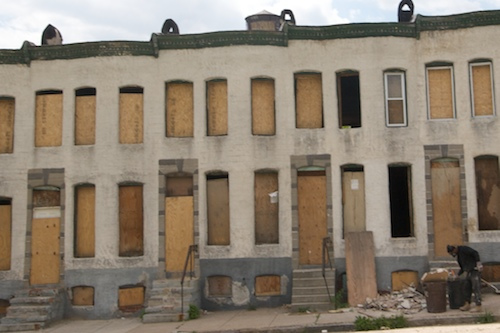Stuff Black People Don’t Like
May 17, 2015
It’s not drugs.
No matter what you saw on The Wire, drugs are not the root cause of the violence in Baltimore. The Baltimore Sun’s Don Rodricks’ shed some light into the type of community black people have cultivated in Baltimore, when he wrote of the plague of “disrespect” killings that causes far more damage to the city than drug wars. [The insanity of Baltimore’s ‘disrespect’ killings: Verdicts take two killers off street, but how do police prevent such murders?, Baltimore Sun, 1-19-14]
One of the latest homicide victims in Baltimore is just another black male, allegedly murdered by another black male.

Well, in virtually every homicide in 63 percent black Baltimore, the murderer and victim share the same racial lineage: black.
Whether the year was 1990, 1999, or 2009, the story remained unchanged: black male found dead from multiple gunshots in Baltimore and a black male suspected in the shooting.
But it’s too easy to just blame drugs as the reason behind the exclusively black violence found in the city.
It creates a boogeyman, which an eternal war must be waged (a war on drugs) in a vain effort to liberate the city of Baltimore from its invisible vise. Rodricks’ piece isn’t far off the mark, with “disrespect” homicide likely the primary cause of the homicide problem in Baltimore.
Though blaming drugs for the body count in Baltimore has worked for years in garnering sympathy for an entirely unsympathetic population (whose role in the demise of the city’s fortune is entirely to due to their inherent genetic code), a simple formula emerges that helps explain the conundrum of black casualties:
Low Impulse Control + Poor Future Time-Orientation + Low IQ (x) jury nullification (black political control)² = Baltimore in 2014
It’s this formula that helps drive down property values and convince owners of capital to invest elsewhere.
It’s this formula that helps explain why “primal anger over dubious acts of disrespect” is unweaving the fabric of civilization in Baltimore. [Man charged with fatally shooting neighbor after Sunday cookout: Brandon Stanfield felt ‘disrespected’ when victim left before his family arrived, according to court documents, Baltimore Sun, 4-22-14]:
A Woodlawn man was charged Tuesday with fatally shooting his neighbor, saying he felt “disrespected” when the victim left a Sunday cookout early, according to charging documents.
Police said Brandon Jerome Stanfield, 30, shot and killed Michael Jefferson Jr., 39, inside his home on Rocky Brook Court after Jefferson left a cookout before Stanfield’s family arrived, one witness told police, according to documents filed in Baltimore County District Court.
Officers found Jefferson dead from multiple gunshot wounds inside his home shortly after midnight Monday after receiving reports of shots fired.
Several witnesses told detectives that they were with Stanfield and Jefferson at a cookout earlier that day and that the two men went inside Jefferson’s home.
Once inside, one witness told police that Stanfield pulled out a .40 caliber Glock and placed it on the kitchen table, and Jefferson told Stanfield he didn’t want guns in his home, the document said. Stanfield then began shooting, and Jefferson tried to flee, running toward the front door. The witness escaped down the basement and left through the back door.
“Disrespected” over a guest leaving your cookout early?
So you shoot him?This is the rational for your typical black homicide in Baltimore.
Not drugs.
Oddly, this was never covered in an episode of David Simon’s The Wire or discussed in either of his books The Corner or Homicide.
Where the little tax revenue generated by the majority black population should be going – city beautification projects like enhancing parks for the enjoyment of families, fixing potholes on streets, improving existing infrastructure like outdated water pipes, or making public transportation more convenient and affordable – instead must go to policing the black community and staffing the support system required to populate Baltimore’s prison-industrial complex. [Baltimore homicides for 1991 reach 304, 1 under ’90 record Shooting of woman marks first of ’92, Baltimore Sun, 1-2-1992]:
In this majority-black city, young black men have dominated the homicide roster in recent years, and 1991 was no exception.
As of Nov. 30, when The Sun put the year-to-date killings at 269, 62.8 percent of homicide victims — or 169 — were black men between the ages of 20-39. When blacks between the ages of 10 and 20 were included, the percentage of victims who were black and male increased to 75 percent.
All of the slain children were black. Among them was 6-year-old Tiffany Smith, who was killed late one summer evening when she was visiting a young friend overnight in the Walbrook area of West Baltimore. She stepped into the path of a shootout between two men. And there was Renae Hicks, an 11-month-old baby allegedly beaten to death last month by her mother and her mother’s boyfriend.
In the final two months of 1991, devastating budget cuts hit Baltimore. Although the Police Department was spared layoffs or furloughs, other areas of the criminal justice system suffered. City prosecutors had to take six furlough days, which in turn meant that the business of bringing criminals to trial didn’t get done for at least a week.
With the city anticipating yet another loss of state dollars — this time perhaps $13.3 million — the prospects for more police or prosecutors in the new year are dim.
“We need more dollars for chemists, analysts, detectives and attorneys,” said Baltimore State’s Attorney Stuart O. Simms. “Dollars are something we don’t have a lot of at the moment.”
Civic enhancements are not a priority in a city majority black metropolis where continually hiring new police department support staff is a major fiduciary concern.
Just one generation ago, the first elected black mayor of Baltimore, the Ivy League educated Kurt
Schmoke, burst onto the national scene with the hopes of saving his beleaguered city.
Giving the city the moniker of the “City That Reads” Schmoke hoped to erase the formula (quoted above) that was already helping to turn much of the white-built housing stock in the city into nothing more than blight, crime infested neighborhoods.
Initially it was greeted with national praise. [Baltimore Targets Its High Rate of Illiteracy; Schmoke Pushing Programs to Make `City That Reads’ More Than Just an Idle Slogan, Washington Post, by Paul Valentine, 8-27-1990]:
You see it everywhere, at bus stops, on park benches, on bumper stickers, on city trucks: a silhouetted figure poised over an open book next to the motto “Baltimore, the City that Reads.”
Not exactly a glitzy slogan, Baltimore Mayor Kurt L. Schmoke acknowledges. But in a city of 720,100 where up to 200,000 adults are functionally illiterate, he says, “it shows where our priorities are.”
On second thought, Schmoke says, literacy is more than a priority. It’s a matter of survival. Yet, of the 200,000 illiterates, only about 3,700 are enrolled in literacy programs at any given moment, according to city estimates. Absenteeism runs high.
And 70 to 90 percent of participants are welfare recipients, mostly women, a kind of captive group that must enroll in education or job training programs to maintain welfare eligibility.
Baltimore, like many older “smokestack” cities with a fading industrial base, is moving rapidly to a service economy-banking, insurance, tourism, health care-where the need for greater literacy and technological savvy grows daily.
“We need to adjust to the economic realities of the future,” says Schmoke, 40, one of the new generation of young black professionals who have become mayors of major U.S. cities. “That’s why these {literacy} programs are so vital.”
“At the receiving dock, it used to be the guy would just unload the truck,” Westinghouse executive Charles Zimmerman says.
“Now he has to enter the information into a computer. “Unless we improve the literacy levels of the people coming into the work force,” says Zimmerman, a board member of Baltimore Reads, a private support group of the city’s literacy campaign, ” . . . these people don’t have a prayer.”
Behind the barrage of slogans, “readathons,” car wash fund-raisers and other promotional gimmicks since Schmoke became mayor in 1987, he has established a new Cabinet-level literacy office and assigned it the Herculean task of teaching legions of people not only to read but to cope with high-tech America.
The numbers are daunting. About one-third of the city’s population above age 16 is functionally illiterate, that is, unable to read at a ninth-grade level.
While that standard may seem high, officials say many have difficulty performing common tasks like reading bus schedules or filling out job applications. Uncounted thousands cannot read at all. Many of the people in literacy programs come from neighborhoods wracked with crime, drugs, teenage pregnancy, unemployment and poverty, problems that hinder attendance, officials say.
Of 5,409 enrolled in programs during the year ending June 30, up to 40 percent dropped out at one point or another.
Almost 37 percent were unemployed. Fourteen percent were nonreaders. “They’re prisoners in their own neighborhoods,” says Maggi Gaines, the city’s literacy boss.
“They can’t read bus and street signs. They can’t read medicine bottles.” “I never worked a job in my life,” says Annette Shellington, 30, a mother of three who completed the eighth grade at age 17 but until recently read at second-grade level.
“I never filled out a job application. I was scared . . . . I was embarrassed.”
Enrolled in a city program, she now reads at fourth-grade level.
It is this black population that gave birth to real moniker of Baltimore: “The City that Bleeds.”
Black women like Annette Shellington birthed the new Baltimore, enabling the formula to become more than just a mathematical theory on a blackboard; ultimately regressing the civilization whites had founded there to the black mean, supported by the offspring of women in similar circumstances as Shellington.
No, it’s not drugs.
It’s this:
Low Impulse Control + Poor Future Time-Orientation + Low IQ (x) jury nullification (black political control)² = Baltimore in 2014
 Daily Stormer The Most Censored Publication in History
Daily Stormer The Most Censored Publication in History


